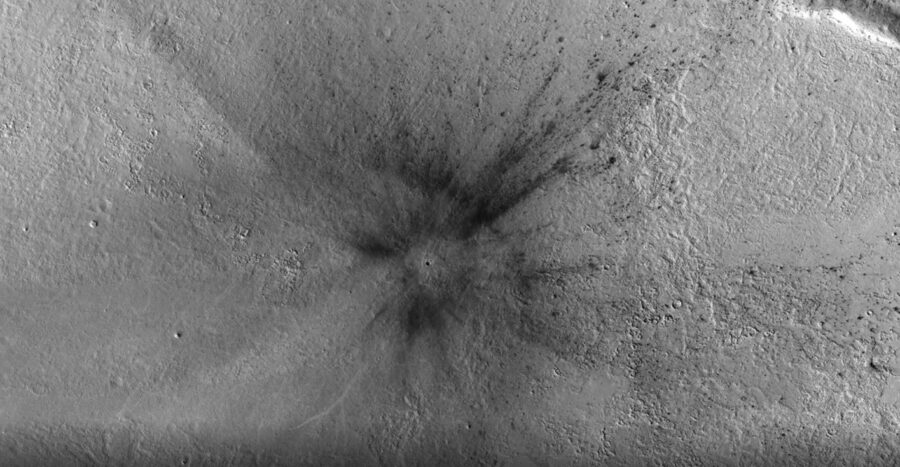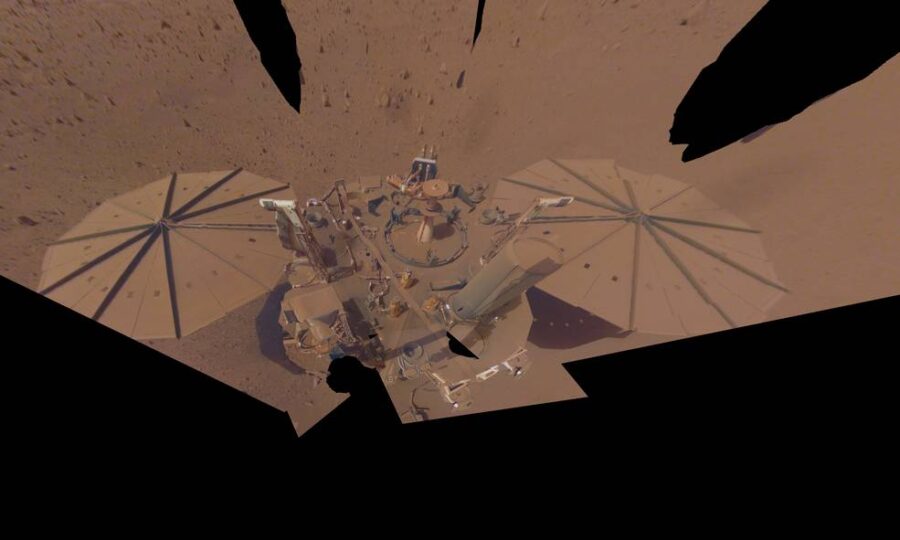NASA’s Mars Insight lander and Mars Reconnaissance Orbiter have witnessed two fresh new planet-probing impacts.

NASA / JPL-Caltech / University of Arizona
Late last year, NASA's Insight lander recorded two of the largest seismic events since it touched down on Mars three years ago. Researchers have since come to realize these were created by meteor strikes rather than shakes within the planet. The impacts, and the marsquakes they created, provide a look into the Red Planet's interior, as reported in Science this week.
The first of these shakes occurred on Christmas Eve in 2021, when Insight detected a magnitude-4.0 marsquake. The event was the fourth-strongest detected on Mars and on of the longest in duration overall, lasting for more than 135 minutes. You can hear a sonification of a piece of the signal here:
Researchers didn't notice the corresponding impact in Mars Reconnaissance Orbiter (MRO) images until a couple months later, on February 11, 2022, and they didn't immediately realize that the crater and seismic event were connected. The fresh crater was visible in images taken by the MRO's Context Camera, which captures black-and-white medium-resolution images of the surface of Mars, as well as Mars Color Imager (MARCI), which makes daily surface maps of Mars.

NASA / JPL-Caltech / University of Arizona
But then the researchers remembered Insight's December 24, 2021, marsquake. Using the daily MARCI images, researchers were able to pin the impact down to the same 24-hour period that InSight had detected the marsquake. The crater's location — in the Amazonis Planitia region, 3,460 kilometers (2,150 miles) from Insight — also matches the marsquake's estimated epicenter.
The find triggered a search for impacts generated during previous large (more than 4th-magnitude) seismic events. The team, led by Liliya Posiolova (Malin Space Science Systems), discovered another fresh crater responsible for a 4.1-magnitude event on September 18, 2021. This new crater is 7,455 km from Insight. Because it was on the other side of the planet's core, and because of its location on the side of a surface depression, the event is more difficult to analyze. The study therefore focuses on the nearer impact event.
Researchers turned MRO’s Hi-Resolution Image Science Experiment (HiRISE) camera to get a closer look at the fresh impact crater. Based on the 0.5-meter-resolution image, the team estimates the impactor that generated the crater was some 5 to 12 meters across.
The impact that generated the December event is the largest new impact crater seen on Mars since MRO arrived in orbit, 16 years ago. "Just seeing such an enormous pair of impacts occur during the Insight mission was a huge surprise!" says team member Bruce Banerdt (NASA JPL). "We initially expected an impact this size to occur only once in a few decades."
Tantalizingly, the bright ejecta exposed by the impact also reveal water ice at only 35°N latitude — the closest to the equator that subsurface ice has been found on Mars.
Probing the Martian Crust
While impacts on Mars are not uncommon — the mission has documented 1,318 marsquakes since it landed in November 2018 — most of these have been much weaker shakes. These two events were strong enough that for the first time, Insight detected waves traveling through the surface of Mars. Surface waves enable scientists to probe the planet's crust.
"We initially were surprised to see surface waves in these events, but not in others the same size," says Banerdt. "But when we learned that they were impacts (and so occurred on the surface) it suddenly made perfect sense, because quakes occurring at depth do not generate as much surface wave energy."
In a second study in Science, Doyeon Kim (ETH Zürich, Switzerland) used the surface waves of both impact events to sample the crust not only directly under the lander, but also all along the line between the lander and the distant points of impact.
Based on the measurements, Kim's team suggests the crust is denser elsewhere on the planet than originally inferred directly beneath the lander. Exactly why the crust is more porous under Elysium Planitia, where the lander sits, is still unclear.
Previous studies based on Insight data had also found the Martian crust (at least under Insight) had either two or three layers. But Kim and colleagues find that the surface waves pass through the crust as if it were only a single layer of uniform density, at least down to 30 km, which is the deepest their method can see.
"The seismic model reported by Kim [and colleagues] offers a more sophisticated way to understand the crustal structures of Mars," write Yingjie Yang and Xiaofei Chen (both at Southern University of Science and Technology, China) in an accompanying perspective piece.
Twilight for Insight
Insight will probably come to an end in December 2022, as its dusty solar panels are steadily losing power. Already, the team reports that Insight is down from 400 watt-hours per sol to less than 300-watt hours per sol, and the team reports that they are now only operating Insight’s seismometer one out of every four days to conserve power.

NASA
However, additional seismometers are in the pipeline for Mars. ESA’s long-delayed ExoMars mission will host a seismometer, and China’s next Tianwen mission could also carry such an instrument.
"Mars Sample Return and preparing for humans are currently using up all the air in the room for Mars missions," says Banerdt. But seismic measurements on other worlds is an expanding prospect, he adds, including a small seismometer on the Dragonfly mission to Titan and another on a commercial lander headed for the Moon in a few years.
Magma and More
Additional study of Insight data, reported in this week's Nature, shows that Mars is geologically still alive. A team led by Simon Stähler (ETH Zurich, Switzerland) analyzed thousands of high-frequency marsquakes, locating their origin in the Cerberus Fossae region. Low-frequency quakes coming from the same region have suggested the presence of recent magma movement some 30 to 50 km below the surface — the remnant of a once-active volcanic region.
It will be sad to see Insight fall silent, but scientists are sure to study its seismic data long after we say goodbye to the lander for good.
 0
0









Comments
You must be logged in to post a comment.